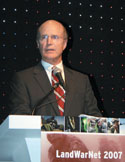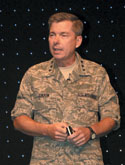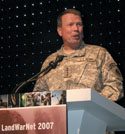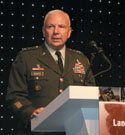Military and Industry Agree on Goals, But Differ on Course
 |
| Secretary of the Army Peter Geren warns against information overload in his address at LandWarNet 2007. |
The transformed infocentric force can count on a future rich in enabling technologies but short on how to achieve common goals, according to many military and industry experts. New capabilities deployed to Iraq and Afghanistan are improving operations for U.S. forces there, but new challenges to interoperability are rising as commercial technologies increase their influence on military systems. And, neither industry nor the military can plot a clear course to achieving a fully network-centric force. Despite agreeing on goals, the two are far apart.
The problem is not that the military is losing sight of its goals, the experts say. It is that all of the new technologies being counted on to achieve network centricity are increasing the military infosphere’s complexity and are adding new issues and challenges. These efforts also are complicated by the changing nature of the Global War on Terrorism and the ongoing force transformation.
Discussion of these points was paramount at LandWarNet 2007, held at the
In addition, the
Maj. Gen. (P.) Jeffrey Sorenson, USA, special assistant to the Secretary of the Army, also endorsed the assessment of persistent conflict—at least for the next couple of decades, he said—and called for similar steps to change Army information technology acquisition. Saying “the Army is flat,” Gen. Sorenson emphasized that the service no longer could conduct business as usual. Neither could the Army wait for grand requirements to be written. Many technologies today could be put together through interplay between warfighters and industry, he offered.
 |
| Brad Boston, senior vice president and chief information officer of Cisco Systems, relates how defense is pushing technology beyond its limits in several areas. |
Among the challenges to network centricity are budget funding, stovepiped systems, procurement practices and certification. Soldiers tend to have too many end-point devices, he added, and effective security is threatened by a “one size fits all” methodology that is the wrong approach to take.
The Army needs more agile approaches to technology, especially when the enemy can operate inside its acquisition cycle. The enemy is very network-centric,
A culture of innovation requires an innovation strategy, and innovation sometimes requires standardization,
“The customer doesn’t really know what he wants until he sees it,”
 |
| Brig. Gen. Jennifer Napper, USA (r), principal director for Global Information Grid operations; commander, Defense Information Systems Agency (DISA) global operations; and deputy commander, Joint Task Force–Global Network Operations, DISA, leads a panel discussing joint operations. Panelists include (l-r) Brig. J.E. Thomas MBE, ADC, British Army; Brig. Gen. George J. Allen, USMC, director, command, control, communications and computers (C4), U.S. Marine Corps; Brig. Gen. Stuart M. Dyer, USAR, Coalition Land Forces Component Command; and Maj. Gen. Walter E. Zink II, USA, commander, Operational Command Post 1, U.S. Army North. |
Gen. Allen noted that operation Iraqi Freedom saw the largest Marine expeditionary force tactical network ever established. But, the “new equipment” the Marines had was four years old. The Corps had to buy commercial gear and install it on top of this equipment—which already was antiquated.
Slow deployment of up-to-date gear is not the only drawback imposed by FAR. The Marine Corps wanted to use Joint Network Node technology, but was forbidden by FAR, the general reported. In this case, FAR prevented the Marines from buying joint. He told Congress, “Change the rules,” adding that he is frustrated by the problems these rules cause.
DISA is trying to work around many of these institutional problems by changing the way it conducts business. Its director, Lt. Gen. Charles E. Croom Jr., USAF, warned that change is inevitable, but growth is not. “Shift happens,” he told the audience. To handle that shift, DISA is trying new approaches that include euthanizing important programs that do not measure up, he declared.
 |
| Lt. Gen. Charles E. Croom Jr., USAF, DISA director, describes how his agency is trying to incorporate speed into the acquisition process. |
Gen. Croom called for more dedication to jointness in systems, implying that many groups give lip service to the concept but do not strive to make it happen. “Don’t call it joint; build it joint,” he advised, adding that the U.S. Army has not always done that. He said to industry, “If you have something I can adapt for the joint world, I’m ready.”
The Net-Enabled Command Capability, or NECC, represents a new way of acquiring information technology. The U.S. Air Force, Army, Navy and DISA will develop it together. Gen. Croom allows that this effort will require a good test area, so the partners are building the Federated Development and Certification Environment (FDCE) to test NECC elements operationally. The FDCE will be the sandbox for NECC, Gen. Croom noted, and he cited the Global Command and Control System (GCCS) as a cautionary tale. The services could not wait, so they built their own GCCS elements. The result was a group of stovepipes. For NECC, DISA will “certify the certifiers.”
NECC will involve software development, and it always is hard to design software to serve people’s needs, the general notes, particularly with current processes for implementing acquisition rules. The commercial sector focuses on speed and is willing to kill a program that is not working well. Gen. Croom wants that approach for NECC.
“We’ve told our folks, ‘Do not fall in love with NECC, because if NECC doesn’t work, we’re going to kill it,’” he emphasized.
His direction for programs is, “You ought to be rushing to failure,” he related. “Fail early and often, learn from that, correct it and move forward.”
Among the new directions being taken by DISA is computing on demand, which Gen. Croom likens to telecommunications access. Instead of buying hardware, a user would pay DISA for computing as if it were electricity. “Why buy a black box when I can do it cheaper?” he asked, noting that DISA pays half as much per satellite transponder than do other government agencies.
A related approach is storage on demand. Calling this “a sea change,” the general observed that many users are comfortable owning their own box. DISA’s 16 computing centers have seen their business grow by 300 percent, and costs are running 25 percent below average. “My goal is to let the services know they cannot compete with me,” he declared.
 |
| Gen. Charles C. Campbell, USA, commanding general of the U.S. Army Forces Command, warns that LandWarNet has points of failure that could bring it down. |
But LandWarNet could have its points of failure, he cautioned. The Army must “get right” the part of LandWarNet that supports joint battlespace communications. However, if the Army allows support for non-joint requirements, then LandWarNet might not succeed.
Secretary Geren declared that LandWarNet will give the Army a vital three-dimensional mesh of ground, airborne and satellite nodes, and he asked industry to help the Army by building inexpensive, secure radios with GPS for every soldier. Technology is moving so fast that what is cutting edge today “could be on the cutting-room floor tomorrow.”
“We cannot afford a modernization holiday,” he emphasized.
 |
| Lt. Gen. William G. Webster Jr., USA, deputy commander of the U.S. Northern Command and vice commander of the U.S. Element in the North American Aerospace Defense Command, describes some of the challenges moving information among diverse organizations. |
Spectrum use remains a challenge, and Gen. Croom believes that a solution lies in more efficient radios. “I’m an optimist that technology will allow radios that use less spectrum,” he offered. This would obviate the need for a spectrum manager. The general also called for mobile devices with high bandwidth rates that work anywhere.
Another item that will bring about significant change is the secure mobile environment-portable electronic device (SME-PED). It will require major policy changes, as “we are behind thinking about how you handle a device that has secure and unsecured” capabilities, Gen. Croom stated. The initial buy of about 10,000 devices should cost approximately $3,300 each, he added.
Gen. Sorenson warned that several gaps loomed for the future. The Army needs modular, scalable and tailorable battle command and control (C2). A dynamic, uninterruptible communications network also is needed. As the Army transforms into an expeditionary force, it must build strategic communications capable of communicating with internal and external audiences. In terms of technology integration, the Army is on the cusp of deploying technologies so advanced that it cannot figure out how to absorb them, he emphasized.
 |
| Brig. Gen. Susan Lawrence, USA (l), commander of the 5th Signal Command, discusses some of the C4 challenges facing the Army. Other members of this joint panel are (r-l) panel moderator Brig. Gen. Jeffrey Foley, USA, commander, U.S. Army Signal Center; Paige Atkins, director, Defense Spectrum Organization, DISA; Brig. Gen. Jeffrey G. Smith, USA, deputy commanding general, U.S. Army Network Enterprise Technology Command/9th Signal Command; and Brig. Gen. Ron Bouchard, U.S. Pacific Command. |
Gen. Metz offered that the top institutional priorities should be to extend the secret Internet protocol router network (SIPRNET) access across the Army, provide Director of Information Management (DOIM) support to the expeditionary Army and enable a unified C2 structure for networks. But, he applied a cautionary TRADOC perspective to this new technology when he asked, “How are we going to train everyone to operate all that Gucci equipment—especially the commander?”
Maintaining a technological edge is not limited to the battlespace.
No discussion of Army C4 technology needs would be complete without a look at
 |
| Fresh off leg surgery, Lt. Gen. Thomas F. Metz, USA, deputy commanding general/chief of staff for the Army Training and Doctrine Command, calls for speeding technologies to the warfighter. |
And, homeland security issues rose to the fore as well. Gen. Webster noted that NORAD needs thorough database management to ensure that it does not illegally maintain data on




Comments